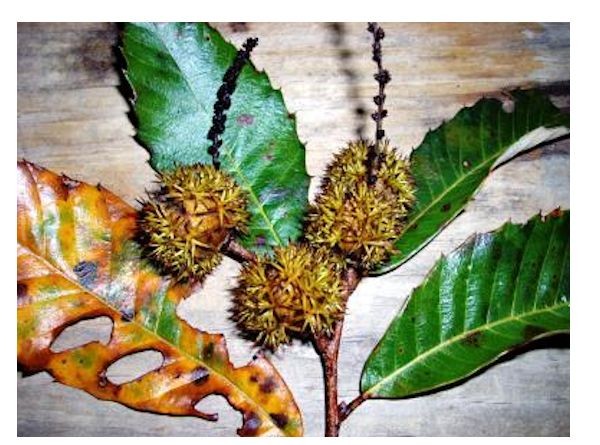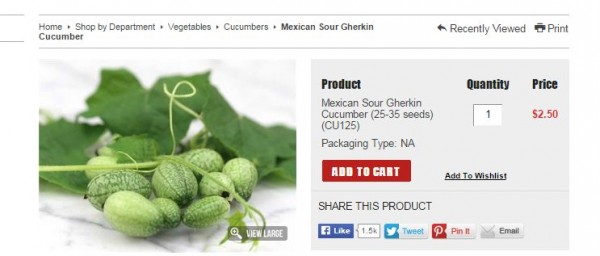Have you ever heard of a Chinquapin tree? The photo was taken from this website and you can go there and read all about the tree. See that little seedpod? It’s about like a giant sand spur but there’s a deliciously sweet nut inside each little prickly pod.
When I was 5 years old, we moved to southwest Louisiana. My parents and my aunt and uncle bought adjoining lots in a little wooded area just on the outskirts of town. On my uncle’s lot was a chinquapin tree. When I look at that seed pod, I have to wonder why on earth I ever explored what was inside but either my dad or my uncle must have told me that it was edible and each year, I would wait and wait, with great anticipation, for the chinquapins to appear and get ripe. Just thinking about them now . . I can almost taste them! It’s a very distinctive taste . . probably not terribly different from an acorn, though I’ve never eaten an acorn, but something about eating the chinquapins always reminded me of eating acorns.
For 40 or 50 years, I’ve asked lots of people if they’ve ever heard of a chinquapin tree and no one has ever admitted knowing what that was. Just last week, we were talking to our neighbors and somehow, I got on the topic of a chinquapin and as always, they had no idea what I was talking about. Vince always says “She’s from Louisiana! They eat anything down there!” . . which is true but, there really was a chinquapin tree.
Here’s the rest of this story . .
The other night Vince was reading something and he asked me if I had ever grown mini Mexican cucumbers.
I had never grown them but I found them at Rare Seeds, where I order lots of seeds, especially the more unusual seeds. I’m anxious to try them! Since I have terrible luck with cucumbers, I’m not optimistic but I’ll give anything a try once.
Then, the name of this seed caught my attention .. Brown Lazy Wife Lentil Bean. 10 seeds for $4. They’d better be real good producers, but again . . I’ll try anything once.
What really caught my attention was this blurb on the Rare Seeds description: “. . but also because when ground, it yielded a unique flour when combined with chinquapins (wild chestnuts) for Pennsylvania Dutch style dumplings, flat breads, and soups.”
Ahh . . chinquapins . . I’m not crazy! That began a google search for chinquapins. I found them at Willis Orchard. Since they grow in zones 7 – 9 and we’re in zone 8, they should work. Three trees have been ordered. It takes 3 – 4 years for them to produce fruit so I hope they produce while we’re here. When/If we leave, I’ll have to leave notes about the “not so normal” things we have growing here and maybe tell the story about how long I’ve wanted these nuts, in hopes that the next owner won’t chop them down.
I’m so happy to have found and ordered those trees. I’ve been wanting them for a very long time and just never took the time to look for them. I believe I was convinced either my dad or my uncle had just made up the name because I’ve never talked to anyone else who had heard of them. Now . . you all know about chinquapins! More worthless info from Judy . . 🙂




Diana in RR,TX says
I guess I had better go back and check out my PA. Dutch cookbooks again! Sometimes the best tasting food comes from the most uninviting shell!
Kat says
I have never had that tree nut, but I have tried the little mini gherkins. It tasted awful! The texture was kind of like a grape, but the flavor was bleh. Maybe it’s an acquired taste?
Terri says
I planted my purchased chestnuts in 1982 in a pot and moved the tree with me to the next place. After we moved the new owner chopped it down. It’s really hard to get seeds of some things now that will germinate. Avocadoes still work. I really love starting trees from seeds and pits. If your wild chestnuts make seed (the part you would eat) take some with you. My chestnut was only 10 or so and making nuts.
Good luck with your trees.
Hugs
Dottie N. says
When I saw the seed pod, I thought it looked a lot like our chestnut trees (in WV). The last few years we lived there (moved to Texas last summer), the chestnut trees were really producing a LOT. We ended up finding many “opened” pods all over our yard (2 acres) because the squirrels WAITED for them to ripen and they “cut” them off the branches. Enjoy your trees!
Pat says
There is a wonderful historic property in Reidsville, NC called Chinquapin. It is really fabulous. It was a working farm owned by a couple with connections to I think Con-Edison Electric and Reynolds Tobacco. They spent their year long honeymoon traveling the world choosing treasures for their new home. I especially remember the jade bedroom they brought back from China. There were some lovely gardens with the Chinquapen trees.
Laura says
I love learning about plants and trees from other regions and countries. I had never heard of a Chinquapin tree! Sounds interesting. We’re zone 8/9, so it could/should work here. Regarding cucumbers, I love what we call “Armenian cucumbers” in central California. Don’t know if that’s the official name. They’re a very light green, thinner than a standard cucumber, and often have a twist or curl in them. Mild and slightly sweet tasting. You may have already tried them; just thought I’d mention it in case you haven’t.
Toni Wood says
Hubby is form the Shenandoah Valley of VA and they grow all over there We finally got back at the right time of fall for him to have some. They remind me of chestnuts.
Diana in RR,TX says
This is Diana, where is your husband from in the SV. Just asking, we lived in Winchester for a while, I went to Shenandoah Conservatory, before it became a university. Anyway, just curious.
Toni Wood says
He is from Waynesboro.
Julie in WA says
Worthless information??? Absolutely not!!
I love these botany lessons from you! You have opened my eyes to all sorts of natural treasures that are foreign to northerners like myself! Thanks for sharing such interesting tidbits with us readers, Judy!
Barbara says
I have heard of them. In fact, there was a small area in East Tennessee called Chinquapin Grove. The location was at the foot of the Appalachian mountains and it was a very isolated area when I was young. I doubt that is the case now.
Judy H says
Now Vince will need to run water to three more trees! 🙂 Poor Vince! LOL
What an orchard y’all are creating! Lots of neat stuff!
Vickie VanDyken says
Love your story and all the comments! Not at all useless. It’s good to learn something new every day. Often my new Item is learned from my friend, Judy 🙂
More interesting than you think !!!
Judy says
We had a chinquapin oak on our family farm in west central Indiana. It was very large but died out in the 80s.
Sherrill P says
I’ve heard of chinquapin trees but never knew about their edible seeds. Interesting! May hafta get a couple for my niece to plant on her property (though the developers have their feelers out in her little area and sounds like they may try to buy up the properties and build McMansions). 🙁
MrsB says
I lived in Baton Rouge for 40 years. Your hubby is kinda right. Ma cher, best damned food in America.
Geaux Tigers.
Jeanette says
They were used by the Indians and gathered as winter food.
Vivian Oaks says
Can’t say I’ve ever heard of your tree, but the leaves AND the pods look an awful lot like the chestnut trees we have in our yard. 30 years ago I used to pick grocery bags full of nuts off the three trees we had. Now we have lots of squirrels, and the trees are half dead, so there are a lot less chestnuts, and the ones we do have are cut from the trees by the squirrels. We’re lucky to get half a dozen nuts now! I’d be interested to see if the taste of the chinquapin is similar to the chestnut.
Penny in So CA says
Oh Judy, I feel very fortunate that I found & now follow your blog. So interesting & I benefit in so many ways from what you write about. It is really amazing the various topics you become interested in, then research & share with us. I hope that you always share such a variety with us.
Alison says
I laughed when you said they probably tasted like acorns but you had never eaten acorns! Ha! Reminds me of the time I was trying to describe the taste of mushhrooms and said they tasted like dust. Now whoever ate dust!
Anita/Idaho says
I’ve heard of chinquapins. My husband was raised in Western North Carolina and he always talked about them. I’ve never seen one or tried one, but I have heard of them.
Joyce Wilson says
Judy,
I have tasted acorns as a curious teenager. Pass it by. Mine was bitter as I remember and hard to get the taste out of my mouth.
Have you tried the spiney loupy oriental express cucumber? My son says that they are not growing it so much any more, but I love it. I rub the pricklys off when I wash it. Have never got a bitter one, and its so dependable when other types are tempermental. Our soil is mostly blow sand, unless I find a pile of cow or horse somewhere, and while I like to plant, I do not have the greenest thumb with the veggies.
Judy L. says
Have not tried that variety but will look for seeds. Thanks for the suggestion.
wanda j says
So funny to read this story. Once again it brings back memories for us. Here in the Houston area we had Chinquapin trees( I’m glad you had to spell it and not me I’d never got it right).Anyway we had them and we all ate them as kids back in the 50’s and 60’s. They were growing around our schools and we ate them as snacks. My husband,I and friends talk about them all the time ( how good they were)but don’t know what happened to the trees. Maybe a blight came through and killed them are they got cut down. Who knows but thanks once again for the mind jogger.
margie says
Chinquapin trees!!!! Yes we have them he in Oregon. Yes ago when we had a wood stove and went out every spring to cut wood we would come across them. They are few and far between. Did not know you could eat the nut. Learn something new everyday!!
JudyL says
You might check with someone else before eating the ones in your area. We were able to eat the ones in Louisiana but . . don’t take my word for it! 🙂
JoanS says
Judy, I have heard of them – not only that, when we lived in Semmes, AL when I was a child, there was one growing in the fence row and I ate the nuts from them. It was a low growing tree and the nuts were easy to reach. At the time, I had never had a chestnut. Now, we attend the fall fair in southern central Tennessee, and one years there was a whole bin of the nuts!
Marcia says
I grew up in western NC – and still live here. My sister, cousins, and I picked chinquapins many times as youngsters on the sides of some of the mountains. I thought they were delicious when I ate them as a child. I haven’t had any in many years, so I don’t know if I would still enjoy the taste. Probably so. I am many years older now and had not thought about chinquapins until your article. Thanks for the reminder. Good luck with the bushes you have purchased.
Vera C. says
Judy,
I found your post on Chinquapins most interesting! I certainly have heard of them and remember my daddy telling me how they used to grow in Arkansas much larger, almost the size of hickory nut or pecan trees. He said a blight hit them (not sure what time period) and as a result the chinquapins now grow much smaller and bushy-like. I once had one growing in the undergrowth of taller trees at the edge of our property. I kept a good watch on the seed pods until a few matured, but didn’t have the courage to taste them. I wish you good success with your chinquapins!